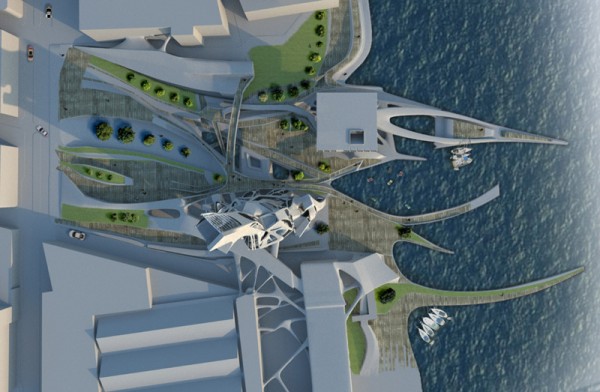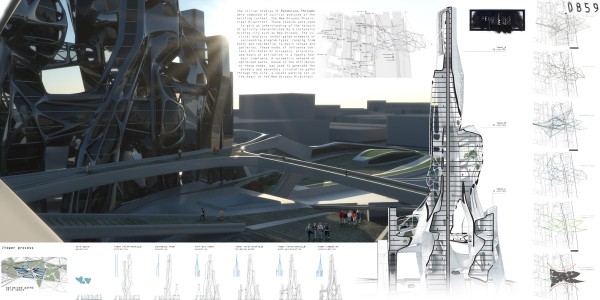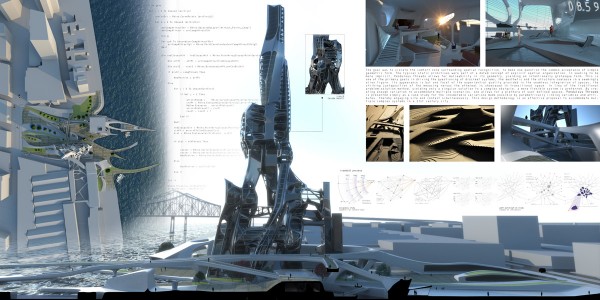Designed by Carlos Augusto García, Luis Quiñones
The initial studies of Pendulous Threads were composed of extensive cyclical analyses of the existing context, the New Orleans Mississippi Riverfront. We employed the use of such studies to gain an understanding of the network of activity characterized by a culturally diverse city such as New Orleans. The cyclical analysis investigated elements of surrounding program types, ranging from hotel and residential, to music venues and galleries. These nodes of influence contain attributes of occupancy, proximity, and hours of activation based on a twenty-four hour timetable. A two-dimensional network of paths, based on the attributes of these nodes, generated the primary and secondary circulation paths through the site, a vacant parking lot in the heart of the New Orleans Riverfront.
Using parametric design techniques, we were able to transition to a complex system of three-dimensional organizational routes. Reapplying the attributes of the existing context to the introduced program facilitated the connection between the initial programmatic study and the emergent program distribution. With these seemingly atypical design methodologies engaging a traditional framework such as the French Quarter of the New Orleans riverfront, the hyperspecific topography employs the use of variation in a previously restrained cityscape. The rift between New Orleans and the Mississippi has created a lack of riverfront development, a driving force behind the will to create a departure from the traditional notion of city-river connection in New Orleans.
In a city, which sits partially below sea level, there is a significant lack of topographical variation. The dated perception of a regularized city grid acted as an additional driver behind the need to create a three-dimensional surface network. These paths provide a unique spatial condition in an area not traditionally characterized by sectional variation.
In deforming this decaying idea of a normalized city grid, a reinterpretation of circulation was developed. The deterministic method of city development is inherently flawed because the varying issues of the growing contemporary city are constantly changing. The solutions to these issues cannot be deterministically developed, instead must be evaluated by a system capable of handling such complexity.
Our goal was to violate the comfort zone surrounding spatial recognition, to make one question the common acceptance of simple geometric form. The typical static primitives were part of a dated concept of explicit spatial organization. In seeking to be more implicit, Pendulous Threads allows for the malleability in its geometry, yielding user-determined spaces in an intentionally grotesque form. This is one of the primary goals in the questioning of discreet systems; the aesthetic and the structural coalesce in a seemingly alien figure. Its appearance is but one facet of the experiential quality provided in the seamless integration of elements; the striking juxtaposition of the menacing versus the ethereal is showcased in interior spaces, against the backdrop of the New Orleans skyline.
In lieu of the traditional problem-solution method, yielding only a singular solution to a complex obstacle, a more flexible system is necessary. By creating enough variation to accommodate multiple scenarios, one allows for a plethora of user-defined spaces. We present Pendulous Threads simply as a case study for the innumerable variations made possible by parametrically linking variables and attributes, thereby engaging site and context simultaneously. This design methodology is an effective proposal to accommodate multiple complex systems in a 21st century city.

















